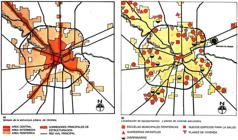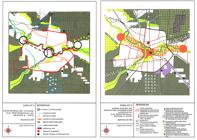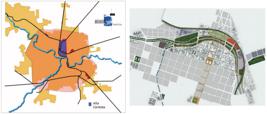Abstract
In 1983, Argentina returned to democracy and, thereafter, different political parties were responsible for the management of the Municipalidad de Cordoba. Each of them has approached the various urban spatial problems of the municipality in a particular way. Over 28 years, these approaches have been modified to a greater or lesser extent, either through continuity, transformation or rupture. Until 1999, there was a succession of governments from the same political party in Cordoba which resulted largely in continuity of urban policy. However, from then on until 2011, this succession process ended and the following three municipal administrations presented their own urban visions and, from these, attempted to transform the urban regulatory framework. This article seeks to analyze the different ways of thinking about urban form, seeking to understand the physical and spatial models of the city desired by each municipal management to face the constant problem of urban growth due to using low housing density in an uncontrolled manner. For this purpose, various urban planning documents published during these three decades are described, presented graphically and analyzed. These lectures focus on the particularities of each document and establish links with other documents from the same period.
Keywords:
Urban planning. Urban morphology. Cordoba.

 Thumbnail
Thumbnail
 Thumbnail
Thumbnail
 Thumbnail
Thumbnail
 Thumbnail
Thumbnail
 Thumbnail
Thumbnail
 Thumbnail
Thumbnail
 Thumbnail
Thumbnail
 Thumbnail
Thumbnail
 Fuente: Elaboración propia a partir de gráficos de Diagnóstico tentativo y alternativas de desarrollo físico para la ciudad de Córdoba, Municipalidad de
Fuente: Elaboración propia a partir de gráficos de Diagnóstico tentativo y alternativas de desarrollo físico para la ciudad de Córdoba, Municipalidad de  Fuente: Elaboración propia.
Fuente: Elaboración propia.
 Fuente: Elaboración propia a partir de gráficos de Desarrollo urbano: reflexiones y acciones,
Fuente: Elaboración propia a partir de gráficos de Desarrollo urbano: reflexiones y acciones,  Fuente: Elaboración propia a partir de gráficos de Plan estratégico para la Ciudad (PEC), Municipalidad de
Fuente: Elaboración propia a partir de gráficos de Plan estratégico para la Ciudad (PEC), Municipalidad de  Fuente: Elaboración propia a partir de gráficos de Formulación de lineamientos alternativos para el plan urbano ambiental, Municipalidad de
Fuente: Elaboración propia a partir de gráficos de Formulación de lineamientos alternativos para el plan urbano ambiental, Municipalidad de  Fuente: Elaboración propia a partir de gráficos de Plan Estratégico de la ciudad de Córdoba. Una ciudad como su gente (PECba), Municipalidad de
Fuente: Elaboración propia a partir de gráficos de Plan Estratégico de la ciudad de Córdoba. Una ciudad como su gente (PECba), Municipalidad de  Fuente: Elaboración propia a partir de gráficos de Bases para el Plan Director. Lineamientos y estrategia general para el reordenamiento del territorio, Municipalidad de Córdoba, & Universidad Nacional de
Fuente: Elaboración propia a partir de gráficos de Bases para el Plan Director. Lineamientos y estrategia general para el reordenamiento del territorio, Municipalidad de Córdoba, & Universidad Nacional de  Fuente: Elaboración propia a partir de gráficos de Programa de densificación urbana, Municipalidad de
Fuente: Elaboración propia a partir de gráficos de Programa de densificación urbana, Municipalidad de